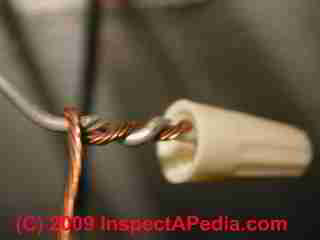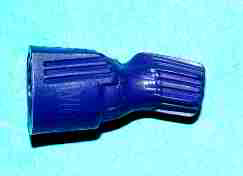 Aluminum Wiring Twist-On Connector
Aluminum Wiring Twist-On Connector
Using twist on connectors with aluminum wiring is risky
- POST a QUESTION or COMMENT about aluminum electrical wiring
U.S. CPSC (Consumer Product Safety Commission) advice about using twist-on connectors (such as the Ideal 65 Twister purple twist on connector) for repairing aluminum electrical wiring.
This brief US CPSC letter provides authoritative documentation confirming that the use of "twist-on" electrical connectors like the ones shown on this page are not a proper nor safe repair for aluminum electrical wiring.
InspectAPedia tolerates no conflicts of interest. We have no relationship with advertisers, products, or services discussed at this website.
- Daniel Friedman, Publisher/Editor/Author - See WHO ARE WE?
U.S. CPSC does not recommend use of Twist On Connectors (including the Ideal No. 65) for Aluminum Wiring Repair
 This information was obtained under the Freedom of Information Act and posted by Daniel Friedman January 1996 or prior.
This information was obtained under the Freedom of Information Act and posted by Daniel Friedman January 1996 or prior.

Dr. Jesse Aronstein Consulting Engineer c/o General Delivery Galway, NY 12074
Re: Twist-On Connectors for Aluminum Wiring
Dear Dr. Aronstein:
In answer to your recent inquiry, the U.S. Consumer Product Safety Commission (CPSC) staff does not consider the use of the twist-on connector (including the Ideal No.65) to be a suitable repair for aluminum wiring in residences.
Acceptable repairs are those identified in the CPSC publication "Repairing Aluminum Wiring" (copy enclosed).
Sincerely,

Enc
...
Continue reading at CPSC CONCERNS RE: ALUMINUM WIRING CONNECTORS or select a topic from the closely-related articles below, or see the complete ARTICLE INDEX.
Or see these
Recommended Articles
- ALUMINUM WIRING HAZARDS & REPAIRS - home
- ALUMINUM WIRING IDENTIFICATION
- ALUMINUM WIRING REPAIR METHODS
- ALUMINUM WIRING REPAIR ELECTRICIANS
- ALUMINUM WIRING REPAIR METHODS - CPSC Meeting 9/28/95
- ALUMINUM WIRING REPAIRS NOT-RECOMMENDED
- CPSC CONCERNS RE: ALUMINUM WIRING CONNECTORS
- CPSC, UL, Ideal Corp, Meeting Log 6/1/95
- REDUCE THE AL WIRE RISK: DETAILS
Suggested citation for this web page
CPSC: UNSUITABILITY of TWIST-ON CONNECTORS (Including the Ideal No. 65) at InspectApedia.com - online encyclopedia of building & environmental inspection, testing, diagnosis, repair, & problem prevention advice.
Or see this
INDEX to RELATED ARTICLES: ARTICLE INDEX to ELECTRICAL INSPECTION & TESTING
Or use the SEARCH BOX found below to Ask a Question or Search InspectApedia
Ask a Question or Search InspectApedia
Try the search box just below, or if you prefer, post a question or comment in the Comments box below and we will respond promptly.
Search the InspectApedia website
Note: appearance of your Comment below may be delayed: if your comment contains an image, photograph, web link, or text that looks to the software as if it might be a web link, your posting will appear after it has been approved by a moderator. Apologies for the delay.
Only one image can be added per comment but you can post as many comments, and therefore images, as you like.
You will not receive a notification when a response to your question has been posted.
Please bookmark this page to make it easy for you to check back for our response.
IF above you see "Comment Form is loading comments..." then COMMENT BOX - countable.ca / bawkbox.com IS NOT WORKING.
In any case you are welcome to send an email directly to us at InspectApedia.com at editor@inspectApedia.com
We'll reply to you directly. Please help us help you by noting, in your email, the URL of the InspectApedia page where you wanted to comment.
Citations & References
In addition to any citations in the article above, a full list is available on request.
- Fire Hazards With Aluminum to Copper Twist-on Connectors & Acceptable Aluminum Wiring Repair Practices Color Photos, Current Issues. 9/28/95 CPSC Meeting Minutes
- "Is YOUR Aluminum Wiring Safe?" article discussing safety claims made by some people without looking at the wiring, J. Aronstein, 11/21/95
- "Repairing Aluminum Wiring", US CPSC Publication 516, U.S. Consumer Product Safety Commission, Bethe3sda MD, website: www.cpsc.gov / www.SaferProducts.gov, updated June 2011, original source: .cpsc.gov/cpscpub/pubs/516.pdf, Quoting:
The U.S. Consumer Product Safety Commission (CPSC) staff and other government officials have investigated numerous hazardous incidents and fires throughout the nation involving aluminum branch circuit wiring.
A national survey conducted by Franklin Research Institute for CPSC showed that homes built before 1972, and wired with aluminum, are 55 times more likely to have one or more wire connections at outlets reach “Fire Hazard Conditions”1 than homes wired with copper. That survey encompassed only the wire connections at outlets.
It did not address other types of aluminum wire connections and splices in homes that are also prone to fail. No information was developed for aluminum-wired homes built after 1972.
The fire hazard investigated by CPSC occurs at connections with aluminum wire, including receptacles or switches and junction boxes; or the hazards occur with major appliances, including dishwashers or furnaces, for example.
There are several deterioration processes in aluminum wire connections that cause increased resistance to the flow of electric current, resulting in damage that is cumulative in effect. That increased resistance causes overheating, sometimes at hazardous levels, when current is flowing in the circuit. - AlumiConn website - www.kinginnovation.com/products/alumiconn/ has installation videos, Wire combinations, specification sheets, and other information and assistance in purchasing or using this product.
- AlumiConn™ AlCopStore.com
223 Salt Lick Road, #279,
St. Peters, MO 63376
Tel: 866-826-2256, Fax: 636-754-0500, Email Sales: pking@AlCopStore.com, Email General Inquiry: info@AlCopStore.com - "Repairing Aluminum Wiring," [As updated 2011] U.S. Consumer Product Safety Commission Publication available online
- "Repairing Aluminum Wiring," [Original, now obsolete] U.S. Consumer Product Safety Commission Publication REPAIRING ALUMINUM WIRING, US CPSC Pub. No. 516available online
- "Record of Commission Action, Commissioners Voting by Ballot", CPSC Publication No. 516, Repairing Aluminum Wiring (original version op.cit.), (Briefing package dated March 15, 2011), Quoting:
The Commission voted unanimously (5-0)·to approve republication of CPSC Publication No. 516, Repairing Aluminum Wiring, with the explicit recognition that the COPALUM and AlumiConn connectors currently are the only products that meet the agency's standards to prevent aluminum wire fire hazards
Copy on file as /aluminum/Pub516_Alumi_Conn.pdf
- Southwire Corporation, manufacturer of aluminum (and other) wire products
- What Owners Need to Know About [Aluminum] Wiring Dangers, Sandra Fleishman, Washington Post, 3 July 2004 pF01

Carson Dunlop's Home Inspector's Home Study Course (DJF is a contributor and participant in this education project).
- Dr. Jess Aronstein, protune@aol.com is a research consultant and an electrical engineer in Schenectady, NY. Dr. Aronstein provides forensic engineering services and independent laboratory testing for various agencies. Dr. Aronstein has published widely on and has designed and conducted tests on aluminum wiring failures, Federal Pacific Stab-Lok electrical equipment, and numerous electrical products and hazards. See ALUMINUM WIRING BIBLIOGRAPHY and see FPE HAZARD ARTICLES, STUDIES for examples.
- "The Influence of Corrosion Inhibitor and Surface Abrasion on the Failure of Aluminum-Wired Twist-on Connections", Aronstein, J.; Campbell, W., Components, Hybrids, and Manufacturing Technology, IEEE Transactions on Volume 7, Issue 1, Mar 1984 Page(s): 20 - 24
- "Overheating Failures of Aluminum-Wired Special Service Connectors", J.Aronstein and W.E.Campbell,
IEEE Transactions, Vol. CHMT-6, No. 1, March 1983.
This paper appears in: Components, Hybrids, and Manufacturing Technology, IEEE Transactions on Publication Date: Mar 1983 Volume: 6, Issue: 1 On page(s): 8 - 15 ISSN: 0148-6411 Current Version Published: 2003-01-06. This paper is available to IEEE members and subscribers and can be obtained through public or academic libraries.
Abstract: Special service" twist-on connectors are tested with aluminum and copper wire combinations. The special service connectors are qualified by a Canadian standard which applies to connectors for use with aluminum branch circuit conductors. Two brands of special service connectors are presently qualified by this standard and marketed. Both are rated for various combinations of aluminum and copper conductors.
Samples of both brands are tested in this investigation. The tests are conducted within rated electrical and environmental conditions, with connections made according to the connector manufacturers' instructions. Overheating failures have occurred among the aluminum-wired special service connector combinations. The failures are accelerated by humid environment to a greater extent than by the application of electrical current. In contrast, connections which are copper-wired, using either standard or special service connectors, are stable and failure-free.
The difference between the standard twist-on connectors and the special service connectors is in the material used for the connector spring. Improved compatibility between the spring material and the aluminum conductor, compared to the plated steel springs of the conventional twist on connectors, has not dealt with several important failure mechanisms. The test results indicate that the new standard, as presently defined, cannot be relied on to screen out aluminum-wired connector combinations which will not survive long-term operation within rated conditions.
Thus the objective of accelerated qualification testing-- the prediction and assurance of safe and reliable operation in actual service---is not achieved in this case. The reasons are discussed, along with possible improvements. - "Evaluation of a Twist-on Connector for Aluminum Wire", Dr. Jesse Aronstein, Forty-Third IEEE Holm Conference on Electrical Contacts, Jan 1997, 0-7803-3968-1/97. [This article describes the Ideal Industries Ideal#65 purple "Twister" twist-on connector marketed as a repair/retrofit for residential aluminum wiring.--DJF]
Abstract:
A new type of twist-on splicing component for use with aluminum and copper wire combinations is tested to determine initial resistance, performance in a zero-current environment test, performance in a heat-cycle test, and portion of current carried by the connector's steel spring. The splices tested consist of two aluminum wires and one copper wire.
The aluminum wire samples used for the test are of the types actually installed in aluminum-wired homes. Initial resistance is found to be relatively high, and there is a significant sample-to-sample variation. This reflects failure to consistently establish low-resistance wire-to-wire contact through the insulating oxide film on the wire. Results of the environmental and heat-cycle tests show deterioration of a significant portion of the samples.
The splices made with this connector are also found to be sensitive to mechanical disturbance, such as applied in normal installation when the completed splice is pushed back in to the junction box. Based on the test results, it is concluded that this connector has not overcome the fundamental deficiency of twist-on connectors for use with aluminum wire applications. Keywords: aluminum wire, connectors, twist-on connectors, environmental test, heat-cycle test. - Harbor Freight Hydraulic Wire Crimping Tool Model 66150 instruction manual
- Marrette® (Brown)Company, (Canadian Thomas & Betts) ACS™ Aluminum Wiring connector product brochure indicates that this connector is "approved for circuits up to 600V and lighting fixtures and signs up to 1000V, not UL Listed (therefore not approved for use in the United States).
- Thomas & Betts, 8155 T&B Boulevard Memphis, TN 38125 USA, is a producer of more than 30,000 electrical components. 888-862-3289. Quoting the company:
Thomas & Betts offers more than 30,000 high-quality products marketed under a variety of market-leading brand names. Designed to help passively conduct electricity, Thomas & Betts products are found everywhere electricity is used -- inside commercial and industrial buildings, in homes and schools, inside complex machinery and original equipment, in the power generating plant and distribution network, outside your home and underground. - Using COALR or CU-AL Electrical Outlets and Switches with Aluminum Wire for the details of these COALR or CU-AL (or AL-CU) products and why they should not be used with aluminum wiring.
- FAQs on author/website credibility
- Directory of Home Inspectors accessible via Internet
- In addition to citations & references found in this article, see the research citations given at the end of the related articles found at our suggested
CONTINUE READING or RECOMMENDED ARTICLES.
- Carson, Dunlop & Associates Ltd., 120 Carlton Street Suite 407, Toronto ON M5A 4K2. Tel: (416) 964-9415 1-800-268-7070 Email: info@carsondunlop.com. Alan Carson is a past president of ASHI, the American Society of Home Inspectors.
Thanks to Alan Carson and Bob Dunlop, for permission for InspectAPedia to use text excerpts from The HOME REFERENCE BOOK - the Encyclopedia of Homes and to use illustrations from The ILLUSTRATED HOME .
Carson Dunlop Associates provides extensive home inspection education and report writing material. In gratitude we provide links to tsome Carson Dunlop Associates products and services.

